Bhushan B. Nanotribology and Nanomechanics: An Introduction
Подождите немного. Документ загружается.

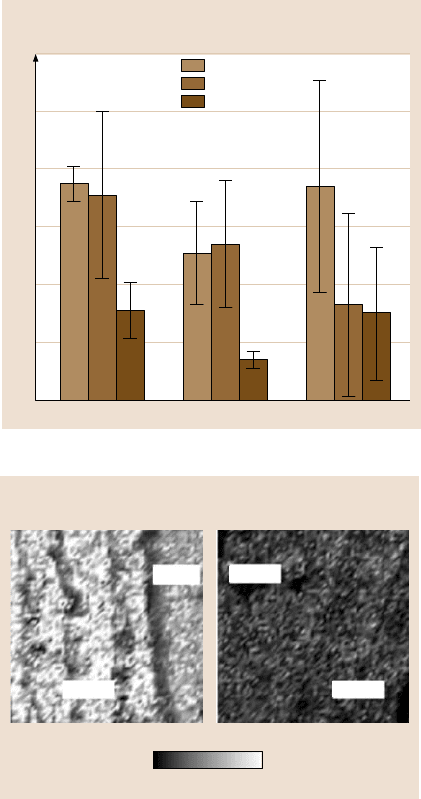
1386 B. Bhushan, C. LaTorre
b)
5-10 %
40-50 %
80-90 %
Virgin
Treated
Damaged
0
12
Young’s modulus (G a)P
2
4
6
8
10
Fig. 24.34. (continued) (b)
effective Young’s modulus
of Caucasian virgin, chem-
ically damaged, and damaged
treated hair samples at differ-
ent humidities [13]
4mμ0
10 GPa0
4mμ0
40-50 % humidity
Cortex
Cuticle
Epoxy
Cuticle
Effective Young’s modulus
90-95 % humidity
Fig. 24.35. Effective Young’s
modulus of virgin Caucasian
hair cross-section at different
humidities [13]
The effective Young’s modulus of the cross-section of virgin hair is shown in
Fig. 24.35. As humidity increases, the Young’s modulus decreases and the differ-
ences between various layers (the cortex, the cuticle, and the epoxy) disappear. Hu-
man hair consists of variouschemical and physical bonds(salt bond, hydrogenbond
anddisulfidebond). Thestrengthof thesebondswill be stronglyaffected bythe level
of water content.
The effective Young’s modulus of various hair surfaces were also measured at
different temperatures. Three different temperatures are studied: room temperature,
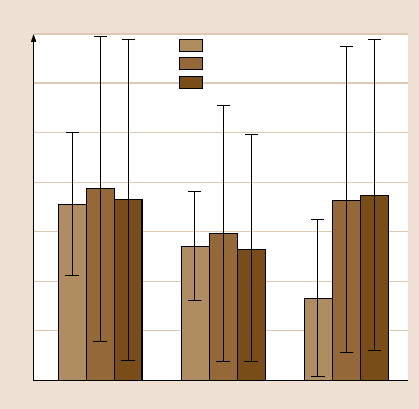
24 Structural, Nanomechanical, and Nanotribological Characterization 1387
22 °C
37 °C
50 °C
Virgin
Treated
Damaged
0
14
Young’s modulus (G a)P
2
4
6
8
10
12
Fig. 24.36. Effective Young’s
modulus of Caucasian virgin,
chemically damaged, and
damaged treated hair samples
at different temperature [13]
human body temperature and a high temperature which represents the temperature
under direct sunshine. Figure 24.36 summarizes the findings for virgin, damaged,
and conditioner-treated hair at those temperatures. For virgin or damaged hair sur-
faces, temperature has little effect on the Young’s modulus due to small range of
temperature studied. The effective Young’s modulus of conditioner-treated hair sur-
face increases as the temperature increases. At high temperature, the conditioner
layer is no longer able to retain the water content and collapses to form a hard shell
covering the surface. Therefore, conditioner treated hair has high effective Young’s
modulus at high temperature.
24.5.2 Scratch Resistance
Nanoscratch technique is capable of simulating the scratch phenomena on hair sur-
face on the nanoscale by scratching the hair surface using a conical diamond tip
(radius about 1µm) and recording the coefficient of friction, in-situ scratch depth
and residual depth.
Nanoscratch on Single Cuticle Cell
Figure 24.37 shows the coefficient of friction and scratch depth profiles as a func-
tion of normal load and tip location on a single cuticle cell of Caucasian and Asian
hair (virgin, chemo-mechanically damaged and virgin treated). The scratch direc-
tion is from left to right. The scratch length was 5 µm and the normal load was
increased from 0.01 to 1mN during scratching. The coefficient of friction of all the
hair samples ranged from 0.3 to 0.6 [89]. The coefficient of friction of virgin treated
Caucasian hair (∼ 0.3) is lower than virginCaucasian hair (∼0.4), and the coefficient
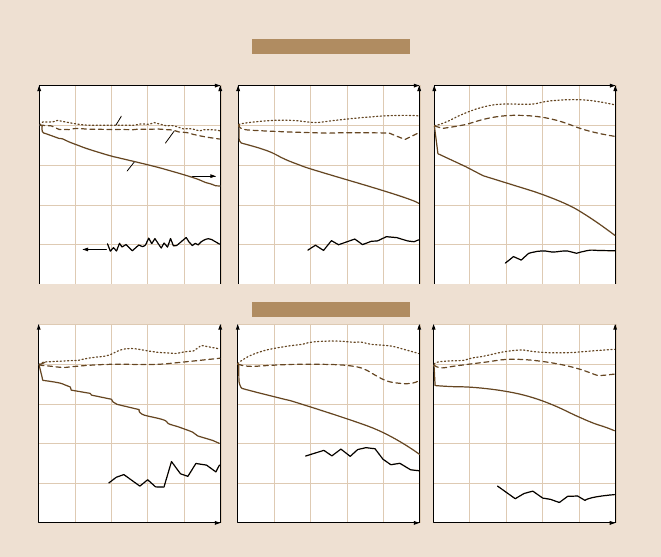
1388 B. Bhushan, C. LaTorre
of friction of virgin treated Asian hair (∼ 0.3) is also lower than virgin Asian hair
(∼ 0.5). The conditioner acts as a thin layer of lubricant on hair surface and it re-
duces the coefficient of friction of hair during scratch. The coefficient of friction of
chemo-mechanicallydamaged hair depends on the type and extent of damage. If the
chemical damage softens the hair surface, then during scratching, the tip plows into
the hair easily, leading to higher coefficient of friction. If the damage hardens the
hair surface or does not change the mechanical properties of the hair surface, then
the coefficient of friction probably will decrease or stay the same during scratch.
Thescratch depth profilesincludethe profiles obtained before(pre-scratch),dur-
ing (in-situ scratch) and after (post-scratch) scratching at scratch length of 5µmand
a maximum normal load of 1 mN as indicated in Fig. 24.37. Reduction in scratch
depth is observed after scratching as compared to that of during scratching. This
reduction in scratch depth is attributed to an elastic recovery after removal of the
normal load. The post-scratch depth indicates the final depth which reflects the ex-
tent of permanent damage and plowing of the tip into the hair surface. The scratch
depth profiles show that at the very beginningof the scratch for all the hair samples,
Virgin
Comparison of coeffcient of friction and scratching
Treated
Caucasian hair, single cuticle cell
Damaged
Asian hair, single cuticle cell
Tip location ( m)μ
2.0
1.6
1.2
0.8
0
1.00
Before scratch
0.2 0.4 0.6 0.8
0.4
1.00
During scratch
0.2 0.4 0.6 0.8
200
0
–200
–400
–800
–600
1.00
After scratch
0.2 0.4 0.6 0.8
2.0
1.6
1.2
0.8
0
0.4
200
0
–200
–400
–800
–600
50 1234 50 123450 1234
Normal load (mN)
Coefficient of friction
Scratch depth (nm)
Fig. 24.37. Coefficient of friction and scratch depth profiles as a function of normal load and
tip location on single cuticle cell of Caucasian and Asian hair (virgin, chemo-mechanically
damaged and virgin treated) [89]
24 Structural, Nanomechanical, and Nanotribological Characterization 1389
the in-situ displacement (30–200nm) increased rapidly at very low load. After that,
it increased gradually. This observation indicates that the top about 200nm of the
hair surface may be softer than the underlying layer. The scratch depth profiles also
show that the reference surface profile before scratch is not very flat, indicating that
human hair has a rough surface. AFM studies have shown that the RMS roughness
of Caucasian and Asian hair surface ranges from 7nm to 48 nm [45]. At 1 mN, the
in-situ scratch depths of all the hair samples range from 300 to 600 nm, and the
residual depths range from 50 to 200nm. Since the thickness of one cuticle cell is
about 300 to 500 nm, during the 1 mN nanoscratch test, the scratch tip might only
penetrate one cuticle cell layer.
Nanoscratch on Multiple Cuticle Cells
Most of the time when we comb our hair, the comb is scratching multiple cuti-
cle cells. Figure 24.38a shows the coefficient of friction and scratch depth profiles
as a function of normal load and tip location on multiple cuticle cells of chemo-
mechanically damaged Caucasian hair obtained in two scratch tests: scratch along
cuticle and scratch against cuticle, and Fig. 24.39b shows the SEM images of the
hair surface after scratch. The coefficient of friction obtained when the tip scratched
the hair against cuticle is significantly higher than the coefficient of friction obtained
when the tip scratched the hair along cuticle, which is known as the “directional-
ity effect”. This is understandable because when the tip scratches the hair surface
against cuticle, the 300–500nm high cuticle “wall” resists the tip to move, leading
to higher coefficient of friction [89].
By observing the surface profiles (before scratch) of Fig. 24.38a, we can clearly
see the shape (height and visible length) of each cuticle cell, i.e., the height is about
300–500nm, and the visible length is about 5–10µm, which is in good agreement
with SEM and AFM data. Thescratch tip acts as a surface profilerbeforescratching.
During scratching, the in-situ displacement increased up to about 3 µmat10mN,
while the residual depth is about 1.5 µm. Considering that the thickness of cuticle is
about 1.5 to 5µm, it is likely that during the 10mN scratch test, the tip reached the
cortex. The SEM images (Fig. 24.38b) clearly show that in both the along cuticle
and against cuticle cases, the cuticle cells were worn away. The topography of the
exposed surface is totally different from the cuticle topography and it is believed
that the exposed surface is the cortex. It can also be seen from Fig. 24.38b that the
scratching against cuticle caused much more damage to the hair than along cuticle.
Given the fact that the “directionality effect” is universal for each human hair
from all races and that the scratching along cuticle is more relevantto our daily life,
we now focus on the scratch tests along cuticle. Figure 24.39a shows the coefficient
of friction and scratch depth profiles as a function of normal load and tip location
on multiple cuticle cells of Caucasian and Asian hair (virgin, chemo-mechanically
damaged and virgin treated) and the SEM images of the scratch wear tracks. Note
that since at least five scratcheswere made on the same hair, some SEM images may
show more than one scratch wear track. For example, the SEM image of chemo-
mechanically damaged Caucasian hair shows two scratches, and the scratch wear
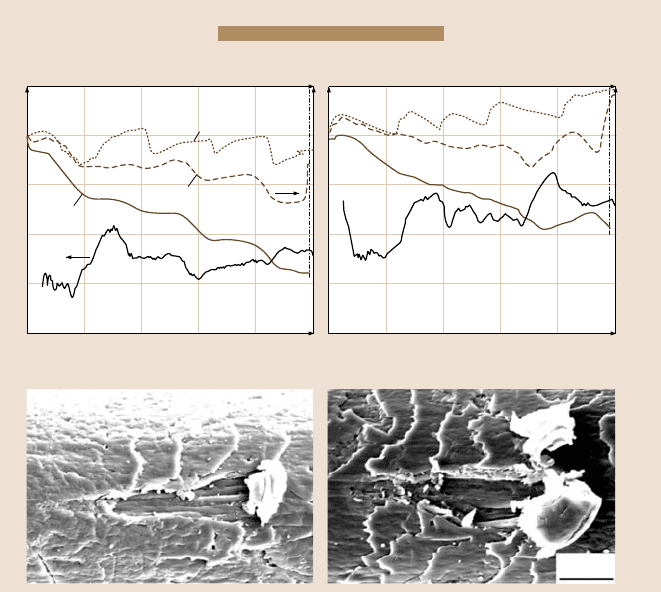
1390 B. Bhushan, C. LaTorre
Coefficient of friction
05010
10 mμ
a)
2.0
1.6
1.2
0.8
0
0.4
T
ip
location ( m)μ
20 30 40
Along cuticle Against cuticle
Normal load (mN)
1000
0
–1000
–2000
–4000
–3000
Scratch depth (nm)
05010 20 30 40
Before scratch
During scratch
After scratch
Directionality effects on coefficient of friction and scratching
Damaged Caucasian hair, multiple cuticle cells
b)
010246
8 0 102468
Fig. 24.38. (a) Coefficient of friction and scratch depth profiles as a function of normal load
and tip location on multiple cuticle cells of chemo-mechanically damaged Caucasian hair ob-
tained in two scratch tests: scratch along cuticle and scratch against cuticle; (b) SEM images
of the hair surface after scratch [89]
track on the right side corresponds to the scratch depth profile. For Caucasian hair,
the averaged coefficient of friction of virgin treated hair (∼ 0.4) is lower than virgin
hair (∼ 0.7). For Asian hair, the averaged coefficient of friction of virgin treated hair
(∼ 0.5) is also lower than virgin hair (∼ 0.8). The trend corresponds well with the
nanoscratch results on single cuticle. Based on this data, it is clear that the condi-
tioner treatment indeed can reduce the coefficient of friction of hair surface upon
scratching. Regarding the chemo-mechanically damaged hair, since the coefficient
of friction of chemo-mechanically damaged hair varies depending on the type and
extent of damage (as discussed above), it is difficult to make comparison with the
virgin or virgin treated hair.
It is worth mentioning that the coefficient of friction of human hair measured by
nanoscratch technique is on the micro-scale, and not on the nano-scale, since the tip
radiusis 1 µm andthe normalload range is 1 to 10mN. It will be shownlater that the
coefficient of friction of conditioner treated hair measured using an AFM tip (radius
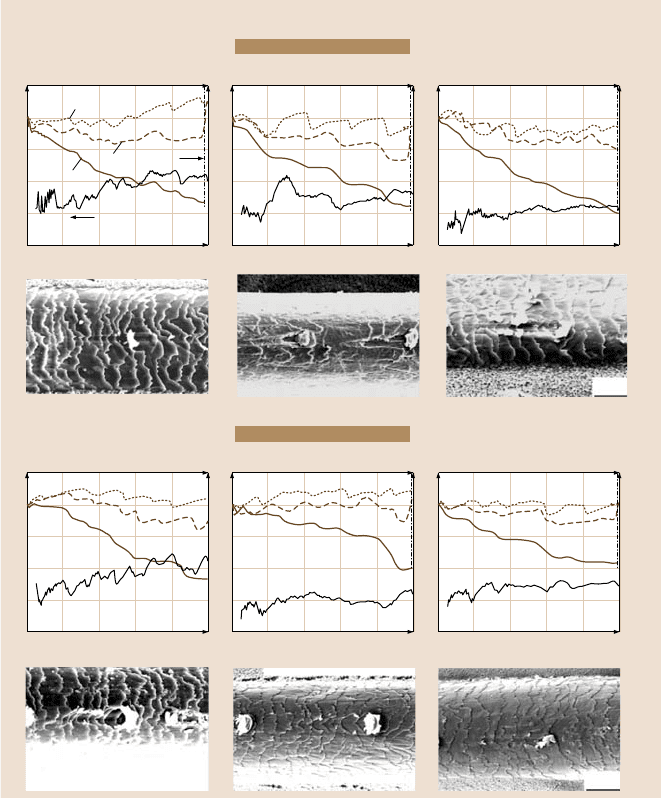
24 Structural, Nanomechanical, and Nanotribological Characterization 1391
Coefficient of friction
Virgin
Comparison of coefficient of friction and scratching
Treated
Caucasian hair, muliple cuticle cells
Damaged
Asian hair, multiple cuticle cells
Tip location ( m)μ
2.0
1.6
1.2
0.8
0
100
Before scratch
2468
0.4
100
During scratch
2468
1000
0
–1000
–2000
–4000
–3000
Scratch depth (nm)
100
After scratch
2468
Normal load (mN)
500 10203040 500 10203040500 10203040
Coefficient of friction
Tip location ( m)μ
2.0
1.6
1.2
0.8
0
1002468
0.4
1002468
1000
0
–1000
–2000
–4000
–3000
Scratch depth (nm)
1002468
Normal load (mN)
500 10203040 500 10203040500 10203040
a)
20 mμ
20 mμ
Fig. 24.39. (a) Coefficient of friction, scratch depth profiles and SEM images of Caucasian
and Asian hair (virgin, chemo-mechanically damaged and virgin treated)
30–50nm), is higher than virgin hair [45]. In the nano-scale, the increase in friction
force is due in part to an increase in meniscus effects which increase the adhesive
force contribution to friction at sites where conditioner is deposited or accumulated
on the hair surface. This adhesive force is of the same magnitude as the normal
load, which makes the adhesive force contribution to friction rather significant. On
the micro-scale, however, the adhesive force is much lower in magnitude than the
applied normal load, so the adhesive force contribution to friction is negligible over
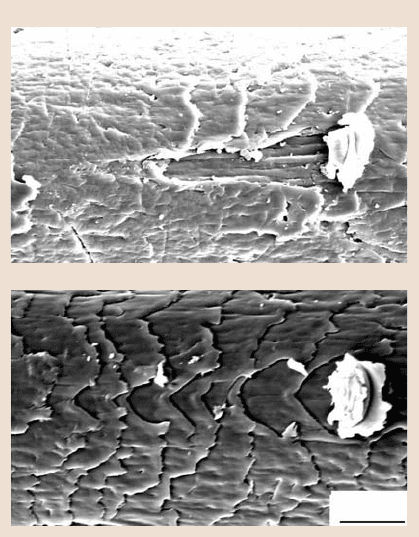
1392 B. Bhushan, C. LaTorre
Damaged Caucasian hair
10 mμ
Damaged Asian hair
b)
Fig. 24.39. (continued)
(b) high magnification SEM
images of damaged Cau-
casian and Asian hair after
scratch [89]
the hair surface. On the micro-scale, the conditioner acts as a thin layer of lubricant,
decreasing the friction.
Figure 24.39b shows the high magnification SEM images of chemo-mechan-
ically damaged Caucasian hair and chemo-mechanically damaged Asian hair after
scratch. It is interesting to find that the failure mechanisms for these two hair are
different. For Caucasian hair, it seems that the tip plowed the cuticle cells contin-
uously during scratching and the plowed cuticle cells were accumulated at the end
of the scratch. As discussed before (also see Fig. 24.38), the exposed surface of the
Caucasian hair is believed to be the cortex. For Asian hair, the tip did not plow the
cuticle cells continuously. Instead, the tip only broke the top cuticle cell of each
cuticle and carried away the broken cuticle cells until the end of the scratch. In this
case, the tip did not reach the cortex during scratching. In order to explain this, we
need to look at the nanomechanical properties of Caucasian and Asian hair. Accord-
ing to mechanical property data reported earlier [90], the cuticle of Asian hair has
a higher hardness (0.39±0.06GPa) than Caucasian hair (0.24±0.05GPa). So the
Asian hair may be more “brittle” than Caucasian hair during scratch. That may be
the reason why Asian hair is fractured easier than Caucasian hair during scratch.
However, it must be noted that our observation is based on limited number samples
and experiments. Since human hair varies from one hair to another even in the same
race, it is hard to draw a general conclusion on hair failure mechanism in terms of
24 Structural, Nanomechanical, and Nanotribological Characterization 1393
the hair race. What we can say is that the hair fails differently during scratching,
depending on the nanomechanicalproperties of the cuticle of the hair.
Figure 24.40 shows the schematic of the various failure mechanisms during
nanoscratching on hair. The top and middle figures show the scratch along cuticle,
and the bottom diagram shows the scratch against cuticle. In the case of scratching
along cuticle, if the hair cuticle is soft (top figure), then the scratch tip will plow the
cuticle and carry away the worn cuticle cells (scales). If the load is high enough,
then the tip can reach the cortex during scratching. After scratching, a newly ex-
posed surface will be created and some pileup is formed at the end of the scratch
wear track. If the hair cuticle is hard (middle figure), then the scratch tip will frac-
ture the cuticle cells instead of plowing deep into them. After scratching, for each
cuticle cell undergoing scratching, part of it is carried away by the tip, resulting
in the formation of small pileup at the end of the scratch wear track, and leaving
behind a series of incomplete cuticle cells. In the case of scratching against cuticle
(bottom figure), the tip will plow the cuticle cells (whether soft or hard) and create
a newly exposed surface with large wedge formation and pileup at the end of the
scratch wear track.
In the studies reported earlier, nanomechanical measurements have also been
performed on African hair [90]. In this study, the curly shape and structure made it
very difficult to perform the nanoscratch on its surface.
Soaking Effect
Figure 24.41a,b compare the coefficient of friction and scratch depth profiles of un-
soaked and soaked Caucasian obtained on single cuticle cell (at 1 mN) and multiple
cuticle cells (10mN loads), respectively. At 1mN, (see Fig. 24.41a), the coefficient
of friction of virgin and chemo-mechanically damaged Caucasian hair increased
from ∼ 0.4to∼ 0.7 after soaking, while the coefficient of friction of virgin treated
hair (∼ 0.3) does not change much. It is known that the human hair swells in wa-
ter. In this work, the hair was only soaked in de-ionized water for 5min. After the
sample was soaked, it took a few minutes to mount the sample and run the scratch
tests. In this case, it is possible that only a few hundred nanometer of the hair sur-
face contained considerable amount water and were softened. During scratching,
it is easier for the tip to plow into the softer hair surface, leading to higher coeffi-
cient of friction. This may be the reason that for 1 mN scratch in which the max-
imum in-situ scratch depths were less than 600 nm, the coefficient of friction of
virgin and chemo-mechanically damaged hair increased. For virgin treated hair in
the 1mN scratch test, however, some of the conditionermolecules mightoccupy the
pathways of water molecules so that the swelling of virgin treated hair was not as
significant as virgin and chemo-mechanically damaged hair. Therefore, the virgin
treated hair shows little change of coefficient of friction after soaking. At 10 mN,
(see Fig. 24.41b), the coefficient of friction of all three hair does not change con-
siderably after soaking. This may indicate that the 5 min soaking did not affect the
hair surface deeply. Table 24.13 summarizes the coefficient of friction and scratch
depths of Caucasian (unsoaked and soaked) and Asian (unsoaked) hair [89].

1394 B. Bhushan, C. LaTorre
Table 24.13. Summary of coefficient of friction and scratch depths of Caucasian (unsoaked
and soaked) and Asian (unsoaked) hair
Unsoaked Caucaisan
Max. normal
load/No. of
cuticle cells
1mN/single cuti-
cle cell
10mN/multiple
cuticle cells
Hair condition Virgin Damaged Treated Virgin Damaged Treated
Average
coefficient
of friction
0.4 0.4 0.3 0.7 0.6 0.4
Max. in-situ
depth (nm)
280 440 650 3250 2500 2750
Max. residual
depth (nm)
25 100 150 1100 1000 750
Soaked Caucasian
Max. normal
load/No. of
cuticle cells
1mN/single cuti-
cle cell
10mN/multiple
cuticle cells
Hair condition Virgin Damaged Treated Virgin Damaged Treated
Average
coefficient
of friction
0.7 0.7 0.3 0.8 0.6 0.5
Max. in-situ
depth (nm)
570 540 500 3000 2100 2600
Max. residual
depth (nm)
130 170 210 1000 500 800
Unsoaked Asian
Max. normal
load/No. of
cuticle cells
1mN/single cuti-
cle cell
10mN/multiple
cuticle cells
Hair condition Virgin Damaged Treated Virgin Damaged Treated
Average
coefficient
of friction
0.5 0.6 0.3 0.8 0.4 0.5
Max. in-situ
depth (nm)
480 500 400 2500 2400 1800
Max. residual
depth (nm)
60 150 130 700 900 480
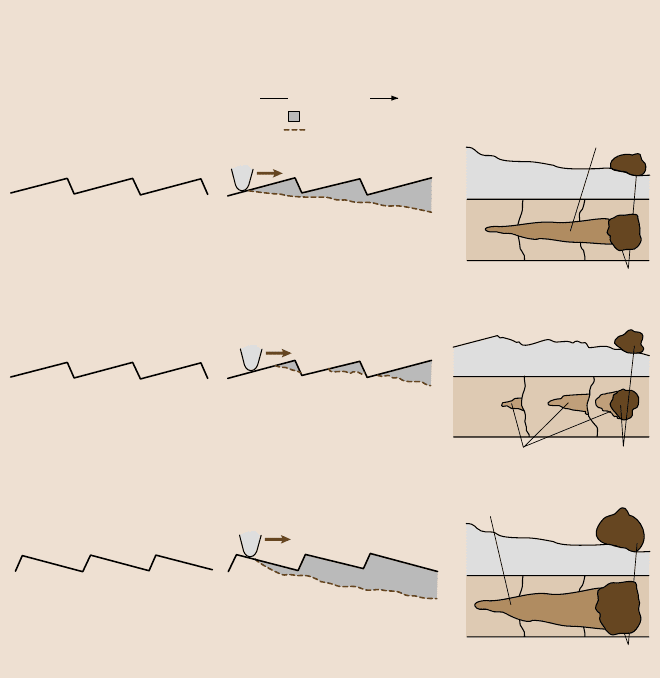
24 Structural, Nanomechanical, and Nanotribological Characterization 1395
Before scratching
(side view)
Various failure mechanisms for nanoscratch on hair
During scratching
(side view)
Scretching load0mN 10mN
Removed cuticle
New surface profile
(Side view)
Cuticle 1
Pileup
Newly exposed surface
Plowing along cuticle scales
(soft hair)
Cuticle 2 Cuticle 3
Cuticle 1 Cuticle 2 Cuticle 3
Scale fracture
Tip
After scratching
(side and top view)
(Top view)
(Side view)
Small
pileup
(Top view)
(Side view)
Large
pileup
Newly exposed surface
(Top view)
Tip
Tip
Fracture along cuticle scales
(hard hair)
Plowing against cuticle scales
(soft or hard hair)
Fig. 24.40. Schematic of the various failure mechanisms during nanoscratching on hair [89]
24.5.3 In-Situ Tensile Deformation Studies on Human Hair Using AFM
Figure 24.42 presentsstress strain curves for fivetypes of hair [74].The stress strain
curve of human hair is similar to that of wool and other such keratinous fibers [95].
When a keratin fiber is stretched, the load elongation curve shows three distinct re-
gions as marked in Fig. 24.42 [4,33]. In the pre-yield region, also referred to as the
Hookean region, stress and strain are proportional, and an elastic modulus can be
found. In this region, there is the homogenous response of alpha keratin to stretch-
ing. The resistance is provided by hydrogen bonds that are present between turns
and stabilize the alpha helix of keratin. The yield region represents transition of ker-
atin from the alpha form to the beta form, the chains unfold without any resistance,
and hence the stress does not vary with strain. The beta configuration again resists
stretching.So, in the post-yield region, the stress again increases with strain until the
